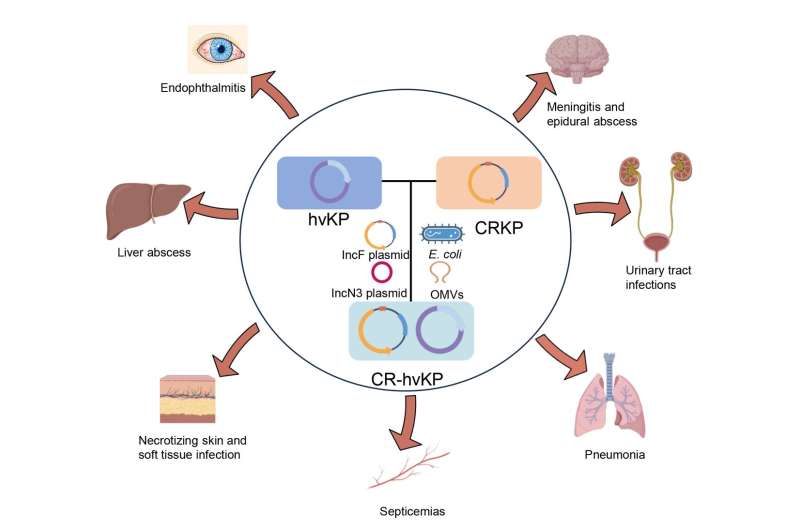This article has been reviewed according to Science X's editorial process and policies. Editors have highlighted the following attributes while ensuring the content's credibility:
fact-checked
trusted source
proofread
'Superbugs' with hypervirulence and carbapenem resistance in Klebsiella pneumoniae

A new bacterial threat, the carbapenem-resistant hypervirulent Klebsiella pneumoniae (CR-hvKP), is rapidly spreading in clinical environments in China, posing a significant public health challenge. This pathogen is simultaneously multidrug-resistant, highly virulent, and highly transmissible, making it a devastating threat.
Historically, hypervirulent Klebsiella pneumoniae (hvKP) has been known to cause severe community-acquired infections, including pyogenic liver abscess, endophthalmitis, and meningitis in young and adult hosts.
However, it has traditionally been susceptible to antibiotics. In contrast, carbapenem-resistant K. pneumoniae (CRKP) is often associated with hospital-acquired infections such as urinary tract infections, pneumonia, septicemias, and soft tissue infections. The rapid outbreaks and spread of CRKP in hospitals have become a major public health challenge due to the lack of effective antibacterial treatments.
Initially, HvKP and CRKP were considered distinct pathotypes in the early stages of K. pneumoniae development. However, the lines dividing the two have blurred, leading to the emergence of CR-hvKP. This new pathogen is particularly concerning as it is multidrug-resistant, hypervirulent, and highly transmissible.
Most CR-hvKP cases have been reported in Asian clinical settings, with China particularly affected. CR-hvKP typically develops when hvKP or CRKP acquires plasmids carrying either the carbapenem-resistance or virulence genes. Alternatively, classic K. pneumoniae (cKP) may acquire a hybrid plasmid carrying both genes.
In this review, researchers provide an overview of the key antimicrobial resistance mechanisms, virulence factors, clinical presentations, and outcomes associated with CR-hvKP infection. They also discuss the possible evolutionary processes and prevalence of CR-hvKP in China.
Given the wide occurrence of CR-hvKP, the researchers emphasize the need for continued surveillance and the implementation of effective control measures against these organisms. The fight against this new bacterial threat requires concerted efforts from health care professionals, policymakers, and researchers to develop strategies for early detection, effective treatment, and prevention of CR-hvKP infections.
The research is published in the journal Science Bulletin.
More information: Danni Pu et al, "Superbugs" with hypervirulence and carbapenem resistance in Klebsiella pneumoniae: the rise of such emerging nosocomial pathogens in China, Science Bulletin (2023). DOI: 10.1016/j.scib.2023.09.040
Provided by Science China Press




















